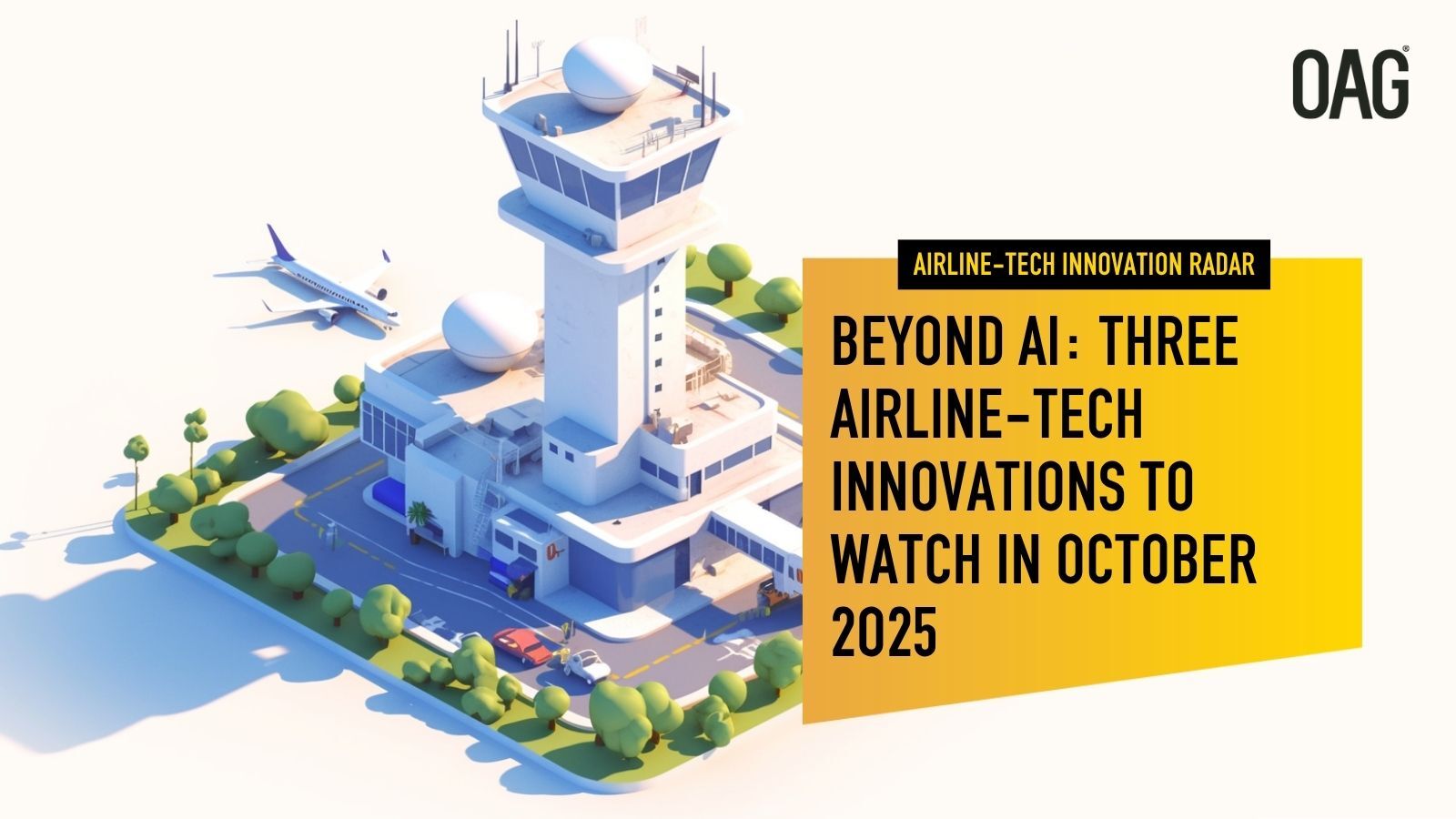After months of back-to-back AI breakthroughs, it feels like every headline in the airline industry and wider Travel Tech is powered by a large language model. Our September edition alone was proof of that. And the momentum hasn’t slowed.
- Expedia just partnered with Perplexity on its new AI-powered browser, a move that could redefine how travelers book flights altogether.
- LATAM launched an AI virtual agent for more personalized trip planning.
- Korea’s Yanolja became the first travel company in the country to adopt ChatGPT Enterprise, embedding GenAI across its operations.
- And Trip.com unveiled Trip.Biz, an AI-driven corporate travel recommendation service ranking the world’s best hotels, restaurants, and destinations across 15,000 cities.
So it’s not that there’s a shortage of AI news. Quite the opposite: the floodgates are wide open. However, few of these latest announcements truly move beyond the use cases we’ve already seen take shape over the past few months (with Expedia’s Perplexity partnership being the notable exception).
That’s why, this month, we’re taking a deliberate pause from the AI hype. October’s Airline-Tech Innovation Radar zooms in on the other side of the innovation spectrum: the advances in aviation technology that aren’t primarily powered by AI but are equally reshaping how the industry operates.
Key Summary:
- JetBlue has announced a partnership with Amazon’s Project Kuiper to deliver high-speed, low-latency satellite-powered Wi-Fi across its fleet starting in 2027 - helping to diversify an increasingly Starlink-dominated market.
- Queenstown Airport has implemented a LiDAR system across five departure areas to monitor passenger flow and reduce congestion.
- IT provider SITA has recently introduced Connect Fly, a next-generation connectivity solution designed to provide airlines and airports with faster, more secure, and more flexible network access.
Innovation #1: JetBlue Partners with Amazon to Power the Next Generation of In-Flight Wi-Fi
In-flight connectivity has long been one of aviation’s most inconsistent promises: fast in theory, frustrating in practice. Now, JetBlue aims to change the game - the airline has announced a partnership with Amazon’s Project Kuiper to deliver high-speed, low-latency satellite-powered Wi-Fi across its fleet starting in 2027.
How does it work?
- The service will rely on low Earth orbit (LEO) satellites to provide faster, more reliable internet than traditional geostationary systems.
- For passengers, that means fewer connection drops on long-haul flights and better coverage over remote regions – a much-needed upgrade from JetBlue’s current Viasat-powered free Wi-Fi service.
Why does this innovation matter so much?
JetBlue isn’t the first airline to adopt satellite-based in-flight internet. Several U.S. carriers, including United Airlines, Alaska Airlines, Hawaiian Airlines, and JSX, already use SpaceX’s Starlink. What makes JetBlue’s move stand out is its choice of partner.
By teaming up with Amazon instead of following the Starlink trend, JetBlue is helping to diversify an increasingly Starlink-dominated market.
Competition at the satellite level is good news for both airlines and travelers:
- As passenger expectations rise – with most travelers now bringing their own devices onboard to stream movies or work online – sluggish, patchy Wi-Fi is no longer acceptable.
- For airlines, more competition also means greater bargaining power when negotiating future satellite internet deals.
JetBlue’s partnership with Amazon signals that the race for in-flight connectivity supremacy is heating up, and it’s no longer a one-player game.

Innovation #2: Queenstown Airport Uses LiDAR to Predict Passenger Congestion Before It Happens
From JetBlue’s New York headquarters, we travel halfway around the world to Queenstown, New Zealand, where one of the world’s most scenic airports is quietly testing one of the smartest crowd-management tools in aviation.
Queenstown Airport has implemented an AI-powered LiDAR system across five departure areas to monitor passenger flow and reduce congestion.
- The technology creates detailed 3D models of terminal environments, tracking movement patterns without capturing any personal data.
- The system provides real-time insights into queue performance, occupancy levels, and even predicts congestion before it occurs, allowing airport staff to respond proactively rather than reactively.
How does it work, and what makes LiDAR different?
LiDAR (short for Light Detection and Ranging) is best known from the world of autonomous vehicles, where it measures distance by sending out laser pulses and analyzing how they bounce back.
The same principle applies here. Instead of using cameras, which record identifiable video footage, LiDAR sensors build an anonymized 3D “point cloud” that represents moving objects (in this case, passengers) as dots rather than faces.
Here’s why that distinction matters:
- Traditional camera-based crowd analytics can raise serious privacy and compliance issues, requiring measures like facial blurring and complex data governance frameworks, especially in Europe.
- LiDAR, by contrast, never captures biometric data in the first place, offering a privacy-preserving way to measure occupancy and movement with high precision.
- It’s a costlier and more complex setup than simply installing cameras, but it’s a far more responsible one.
Why does this innovation matter so much?
First, airports are becoming the true bottlenecks in our global air travel networks. Passenger volumes continue to climb worldwide, but airport infrastructure isn’t expanding fast enough to keep pace. Peak-hour congestion remains one of the industry’s biggest operational headaches, and Queenstown’s approach shows how predictive analytics can help manage flows before queues even form.
Secondly, in an era of growing concern over surveillance, Queenstown’s LiDAR deployment demonstrates that smarter airports don’t have to mean more intrusive ones. By combining accuracy with anonymity, this model could set a new global standard for airport crowd monitoring.
Last but not least: a better experience means better business. Constant queueing and waiting are among the biggest pain points for travelers. When passengers spend less time in line, they have more time to spend in shops, cafés, or lounges. Therefore, a smoother journey is not only a service upgrade but also a commercial one.
In short, Queenstown Airport’s LiDAR system makes the terminal fairer, calmer, and more efficient. It’s a small airport showing big airports how to innovate responsibly.

Innovation #3: SITA Upgrades Airline Connectivity with Cloud-Native SD-WAN Technology
From an airline to an airport, and now to the IT backbone of the air transport industry: SITA.
The company has recently introduced Connect Fly, a next-generation connectivity solution powered by Versa’s VersaONE platform. It’s designed to provide airlines and airports with faster, more secure, and more flexible network access, essentially modernizing the digital infrastructure that keeps aviation running.
How does it work?
At its core, Connect Fly uses software-defined wide-area networking (SD-WAN), a technology that dynamically manages data traffic across multiple connection types, including 5G, fiber, and standard internet links.
Instead of relying on fixed, hardware-heavy networks, SD-WAN enables airlines to connect mission-critical systems, such as departure control systems (DCS), check-in counters, and boarding gates, through cloud-native infrastructure.
That shift brings several tangible benefits:
- Speed: Setting up new stations or remote outposts can now take weeks instead of months, a major advantage for airlines expanding to new destinations or operating seasonal routes.
- Resilience: The system continuously monitors network conditions and automatically reroutes traffic if a link fails, which is crucial for keeping check-in kiosks, baggage systems, and crew operations online.
- Flexibility: Because Connect Fly supports multiple connectivity layers (from traditional ISP connections to emerging 5G networks), airports and airlines can tailor bandwidth based on local availability and cost.
Why does this innovation matter so much?
At first glance, this might sound like incremental IT housekeeping, but its multiplier effect across the industry is anything but minor.
- The aviation ecosystem relies on thousands of interconnected systems that must talk to each other in real time, from airport kiosks and gate readers to crew apps and flight management software.
- A more robust, flexible, and faster communication layer means fewer outages, faster recovery times, and smoother passenger processing everywhere.
For airlines, this also unlocks more agile operations. Imagine an airline launching a new route to a remote airport:
- Previously, network setup alone could delay the first flight by months.
- With Connect Fly’s cloud-native SD-WAN, connectivity can be established in weeks, potentially speeding up route launches, reducing setup costs, and enabling temporary or pop-up operations during peak seasons.
In short, SITA’s Connect Fly may not have the same flash as passenger-facing AI tools (which we will cover again next month), but its industry-wide impact could be far greater.
Strengthening the network backbone of aviation means every system above it (including AI operations) runs faster, safer, and smarter.

Speak to you again next month, when AI will surely make its comeback.







